Rhodanide
Hazard to Others
  
Posts: 348
Registered: 23-7-2015
Location: The 80s
Member Is Offline
Mood: That retro aesthetic
|
|
An unknown, yellow Nickel compound
Last night, I was having fun making the Biuret complex with Copper.
So, I thought I'd have a go at making the Nickel version. I dissolved Biuret in distilled water and added NaOH to make it alkaline. I then added a
small amount of concentrated NiCl2 solution (Picture 1), and got a precipitate of Ni(OH)2, as expected. Upon stirring and
addition of more NaOH, the Hydroxide dissolved and a yellow solution was obtained (Picture 2). The color was a light orange-yellow, which darkened
upon addition of more NaOH (Picture 3, taken after filtering Ni Hydroxide off). I thought that I could precipitate the Nickel complex like I did with
the Copper version. I added Acetone, again, just like the Copper complex. Instead of a Lilac precipitate, I was left with two immiscible layers
(Picture 4). However, some yellow color did seem to move to the upper acetone layer, which I decanted some of into another beaker (Picture 5). What
could this be? Why didn't it precipitate like the Copper complex did?
This is very interesting to me and I'd enjoy seeing what you all think.
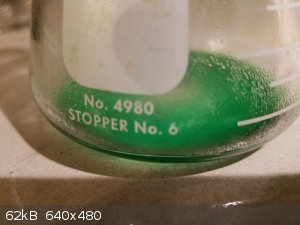 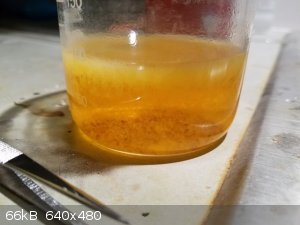 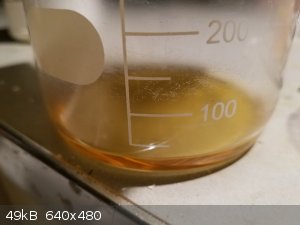 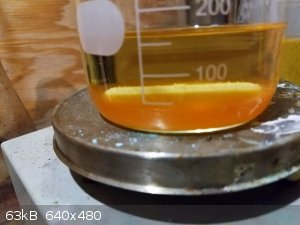 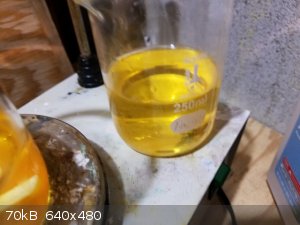
|
|
|
unionised
International Hazard
    
Posts: 5102
Registered: 1-11-2003
Location: UK
Member Is Offline
Mood: No Mood
|
|
Have you ruled out the idea that the yellow colour is due to degradation products of acetone?
|
|
|
Rhodanide
Hazard to Others
  
Posts: 348
Registered: 23-7-2015
Location: The 80s
Member Is Offline
Mood: That retro aesthetic
|
|
That's really not possible, the color was seen before any acetone was added.
|
|
|
Boffis
International Hazard
    
Posts: 1836
Registered: 1-5-2011
Member Is Offline
Mood: No Mood
|
|
You haven't quoted any quantities so its difficult to judge what you have obtained but I see no reason why biuret would give a yellow-orange complex.
If you haven't got the ratios right you could have ended up with another complex , possibly in a different oxidation state. Also what is the source of
your reagent? In other words how certain are you that the components of the reaction mixture are what they are supposed to be?
The fact that there is little precipitate produced by on further addition of NaOH suggests that a complex has formed. Have you tried extracting it
with an immiscible solvent like amyl alcohol, ethyl acetate etc.? Also do you know that the nickel-biuret complex is lilac and is there only one
complex? What is the expected valency of the nickel, there are for example known Ni3+ complexes though I don't known what colour they are.
|
|
|
The Volatile Chemist
International Hazard
    
Posts: 1981
Registered: 22-3-2014
Location: 'Stil' in the lab...
Member Is Offline
Mood: Copious
|
|
| Quote: | | In low-pH or neutral conditions, biuret commonly shows O,O′-bidentate coordination to metal cations [e.g. with zinc (Nardelli et al., 1963[Nardelli,
M., Faca, G. & Giraldi, G. (1963). Acta Cryst. 16, 343-352.]), copper (Freeman & Smith, 1966[Freeman, H. C. & Smith, J. E. W. L. (1966).
Acta Cryst. 20, 153-159.]) or samarium (Haddad, 1987[Haddad, S. F. (1987). Acta Cryst. C43, 1882-1885.])]. |
Which:
| Quote: | | Aqueous solutions of NiCl2 and biuret (both 0.1 M) were mixed in a 1:1 ratio at room temperature, resulting in a green solution. Small block-like
green crystals of (I)[link] grew over the course of a few days as the water slowly evaporated and were harvested by vacuum filtration and washing with
acetone. |
However:
| Quote: | | When biuret is deprotonated in basic conditions, N,N′-bidentate coordination can arise [e.g. with copper (Pajunen & Pajunen, 1982[Pajunen, A.
& Pajunen, S. (1982). Acta Cryst. B38, 1586-1588.])]. |
I don't know much about biuret coordination chem, and I might be missing something, but it's possible that you just switched which part of the
molecule was coordinating with the nickel.
Source:http://journals.iucr.org/e/issues/2005/03/00/sj6047/
|
|
|
Rhodanide
Hazard to Others
  
Posts: 348
Registered: 23-7-2015
Location: The 80s
Member Is Offline
Mood: That retro aesthetic
|
|
Quote: Originally posted by Boffis  | You haven't quoted any quantities so its difficult to judge what you have obtained but I see no reason why biuret would give a yellow-orange complex.
If you haven't got the ratios right you could have ended up with another complex , possibly in a different oxidation state. Also what is the source of
your reagent? In other words how certain are you that the components of the reaction mixture are what they are supposed to be?
The fact that there is little precipitate produced by on further addition of NaOH suggests that a complex has formed. Have you tried extracting it
with an immiscible solvent like amyl alcohol, ethyl acetate etc.? Also do you know that the nickel-biuret complex is lilac and is there only one
complex? What is the expected valency of the nickel, there are for example known Ni3+ complexes though I don't known what colour they are.
|
The reason I didn't quote any quantities is because I didn't measure anything out. I just wanted to see if it would work. The sources of my reagents
are not perfectly pure. Pottery-grade basic Nickel Carbonate, technical grade HCl from the hardware store, Biuret from heating Urea via instant cold
packs, Acetone from a can. Basic stuff. It's just not viable for me to use ultra-pure reagents. Also, I have no idea why I'd even bother buying Amyl
Alcohol or Ethyl Acetate (That's saying I can even find them to buy online, things are getting scarce) because they're pretty much useless to me and
there are a lot more accessible (and affordable) immiscible solvents available to me. Reminder: I'm doing this stuff in a corner of my garage, not in
a University's lab.
[Edited on 9-11-2017 by Tetra]
|
|
|
woelen
Super Administrator
        
Posts: 7976
Registered: 20-8-2005
Location: Netherlands
Member Is Offline
Mood: interested
|
|
Instead of buying expensive reagent grade chemicals you also can buy some equipment, allowing you to make pure chemicals yourself.
Of your list I have most doubts with the HCl. If the HCl is not clear like pure water, but somewhat yellowish, then it almost certainly contains quite
some iron(III) and this may affect many sensitive coordination chemistry experiments.
I myself distilled hardware store HCl, using glass distillation apparatus (no need to use water cooling with 20% HCl). I took 30% HCl from the
hardware store, diluted so that it is appr. 23% (a little over azeotropic) and then distilled such that 80 to 90% of the liquid was distilled over. I
discarded the remaining little amount (which was deep yellow/green) and kept the perfectly colorless 85% or so of the liquid which came over in the
distillation apparatus. This is perfectly fine HCl, good also for sensitive experiments.
From pottery grade BaCO3 I made nice pure crystalline BaCl2, you can make crystalline NiSO4.6H2O from your (impure) NiCO3. With purifications of these
dirt cheap chemicals I do not aim for the last 10 to 20%. Getting that pure is a pain in the ass, and not worth the effort with the cheap sources.
Then just use a little more of the cheap starting materials. This also is true for crystallization. I stop crystallizations well before I have 100%
recovery. The last part of the recrystallized material will have more impurities.
So, investing in a simple glass distillation setup is really worth the money. Besides that, it also is fun and rewarding to have your own home made
pure chemicals. In this way I made (among others) the following pure chemicals from cheap pottery grade materials:
- pure HCl, from hardware store HCl
- BaCl2 (from BaCO3, 6% H2O2 and pure HCl)
- NiSO4 (from NiCO3 and H2SO4)
- NH4VO3 (from pottery grade V2O5 and supermarket NH3)
- Na2MoO4 (from pottery grade MoO3 and drugstore NaOH), this is not really pure, also contains Na2CO3, but is free of iron, which the original MoO3
was not
- KClO3 (from KCl, electrolysis)
- KBrO3 (from KBr, electrolysis)
- KIO4 (from KI, technical grade KOH for soap making, hardware store HCl and swimming pool chlorinator)
- Na2H3IO6 (from NaI, drugstore NaOH, hardware store HCl and swimming pool chlorinator)
Sometimes it is hard to make a certain pure chemical, but it is easy to make it such that certain types of impurities are not present. An example is
my Na2MoO4. My original pottery grade MoO3 was a brown powder, containing a lot of iron and also a lot of insoluble stuff, when dissolved in a
solution of NaOH. After purification I obtained an alkaline white solid, which has no heavy metal contaminants and allows me to experiment with
Mo-compounds without interference of other colored metal salts. The presence of some carbonate, sodium ions and possibly some excess hydroxide is not
a real problem, they can be neutralized and the sodium ions do not interfere.
So, maybe it is an idea to do your nickel experiments with more pure chemicals, you make yourself. IIRC biuret (and also urea) gives intensely
red/brown colored complexes with iron(III) salts at high pH. These complexes may explain the yellow color of your solution. For this reason it would
be nice to retry with more pure reactants.
|
|
|
Rhodanide
Hazard to Others
  
Posts: 348
Registered: 23-7-2015
Location: The 80s
Member Is Offline
Mood: That retro aesthetic
|
|
Quote: Originally posted by woelen  | Instead of buying expensive reagent grade chemicals you also can buy some equipment, allowing you to make pure chemicals yourself.
Of your list I have most doubts with the HCl. If the HCl is not clear like pure water, but somewhat yellowish, then it almost certainly contains quite
some iron(III) and this may affect many sensitive coordination chemistry experiments.
I myself distilled hardware store HCl, using glass distillation apparatus (no need to use water cooling with 20% HCl). I took 30% HCl from the
hardware store, diluted so that it is appr. 23% (a little over azeotropic) and then distilled such that 80 to 90% of the liquid was distilled over. I
discarded the remaining little amount (which was deep yellow/green) and kept the perfectly colorless 85% or so of the liquid which came over in the
distillation apparatus. This is perfectly fine HCl, good also for sensitive experiments.
From pottery grade BaCO3 I made nice pure crystalline BaCl2, you can make crystalline NiSO4.6H2O from your (impure) NiCO3. With purifications of these
dirt cheap chemicals I do not aim for the last 10 to 20%. Getting that pure is a pain in the ass, and not worth the effort with the cheap sources.
Then just use a little more of the cheap starting materials. This also is true for crystallization. I stop crystallizations well before I have 100%
recovery. The last part of the recrystallized material will have more impurities.
So, investing in a simple glass distillation setup is really worth the money. Besides that, it also is fun and rewarding to have your own home made
pure chemicals. In this way I made (among others) the following pure chemicals from cheap pottery grade materials:
- pure HCl, from hardware store HCl
- BaCl2 (from BaCO3, 6% H2O2 and pure HCl)
- NiSO4 (from NiCO3 and H2SO4)
- NH4VO3 (from pottery grade V2O5 and supermarket NH3)
- Na2MoO4 (from pottery grade MoO3 and drugstore NaOH), this is not really pure, also contains Na2CO3, but is free of iron, which the original MoO3
was not
- KClO3 (from KCl, electrolysis)
- KBrO3 (from KBr, electrolysis)
- KIO4 (from KI, technical grade KOH for soap making, hardware store HCl and swimming pool chlorinator)
- Na2H3IO6 (from NaI, drugstore NaOH, hardware store HCl and swimming pool chlorinator)
Sometimes it is hard to make a certain pure chemical, but it is easy to make it such that certain types of impurities are not present. An example is
my Na2MoO4. My original pottery grade MoO3 was a brown powder, containing a lot of iron and also a lot of insoluble stuff, when dissolved in a
solution of NaOH. After purification I obtained an alkaline white solid, which has no heavy metal contaminants and allows me to experiment with
Mo-compounds without interference of other colored metal salts. The presence of some carbonate, sodium ions and possibly some excess hydroxide is not
a real problem, they can be neutralized and the sodium ions do not interfere.
So, maybe it is an idea to do your nickel experiments with more pure chemicals, you make yourself. IIRC biuret (and also urea) gives intensely
red/brown colored complexes with iron(III) salts at high pH. These complexes may explain the yellow color of your solution. For this reason it would
be nice to retry with more pure reactants. |
Alright, that's exactly what I was looking for. Thanks, I'll try those things. (Wow, you must have a fancy pottery supply store, MoO3, whoo)
[Edited on 11-11-2017 by Tetra]
|
|
|
kmno4
International Hazard
    
Posts: 1495
Registered: 1-6-2005
Location: Silly, stupid country
Member Is Offline
Mood: No Mood
|
|
This is not unknown compound, but laziness.
1 minute o googling gives "bright yellow powder", as result of reaction of biuret, Ni salt and KOH.
Besides, Junk Chemicals = Junk Results.
Detritus.
Слава Україні !
Героям слава !
|
|
|
The Volatile Chemist
International Hazard
    
Posts: 1981
Registered: 22-3-2014
Location: 'Stil' in the lab...
Member Is Offline
Mood: Copious
|
|
Quote: Originally posted by kmno4  |
This is not unknown compound, but laziness.
1 minute o googling gives "bright yellow powder", as result of reaction of biuret, Ni salt and KOH.
Besides, Junk Chemicals = Junk Results.
Detritus. |
And one minute of typing would remove ridiculous things like 'o' from your sentences too.
Tetra sould repeat the experiment and try to duplicate results with known quantities and more pure compounds, and repost here.
|
|
|
woelen
Super Administrator
        
Posts: 7976
Registered: 20-8-2005
Location: Netherlands
Member Is Offline
Mood: interested
|
|
Quote: Originally posted by kmno4  |
This is not unknown compound, but laziness.
1 minute o googling gives "bright yellow powder", as result of reaction of biuret, Ni salt and KOH.
Besides, Junk Chemicals = Junk Results.
Detritus. |
If you don't have anything useful to say, then please don't say anything. This is the
best way to kill someone's interest in the subject 
Many people start with very limited resources and with little or no experience. This is inherent to an amateur/hobby setting. Probably even you
started like that (maybe in the pre-internet era). If you cannot tolerate people like that, then please try to find another forum, where there are
only well-equipped lab-people, with an academic background and years of high quality exprience. A hobby forum then is not your place to go.
|
|
|
NEMO-Chemistry
International Hazard
    
Posts: 1559
Registered: 29-5-2016
Location: UK
Member Is Offline
Mood: No Mood
|
|
Quote: Originally posted by Tetra  | Last night, I was having fun making the Biuret complex with Copper.
So, I thought I'd have a go at making the Nickel version. I dissolved Biuret in distilled water and added NaOH to make it alkaline. I then added a
small amount of concentrated NiCl2 solution (Picture 1), and got a precipitate of Ni(OH)2, as expected. Upon stirring and
addition of more NaOH, the Hydroxide dissolved and a yellow solution was obtained (Picture 2). The color was a light orange-yellow, which darkened
upon addition of more NaOH (Picture 3, taken after filtering Ni Hydroxide off). I thought that I could precipitate the Nickel complex like I did with
the Copper version. I added Acetone, again, just like the Copper complex. Instead of a Lilac precipitate, I was left with two immiscible layers
(Picture 4). However, some yellow color did seem to move to the upper acetone layer, which I decanted some of into another beaker (Picture 5). What
could this be? Why didn't it precipitate like the Copper complex did?
This is very interesting to me and I'd enjoy seeing what you all think.
|
I applaud your ability to take pics and experiment! it never goes well for me when i do it, i either miss something timing wise or break the camera
with chems or dropping!!
Interesting what Woelen was saying about HCl, I have reasonable quality acid, but i know to watch out for iron impurities now.
Would be cool if you do this again but with distilled acid this time, if you get different result then you have shown graphically what a couple % of
impurity can do. I also normally use cheap chems.
I like cleaning them up anyway, something calming about doing a recrystallization! Or maybe I just need a life 
|
|
|
Rhodanide
Hazard to Others
  
Posts: 348
Registered: 23-7-2015
Location: The 80s
Member Is Offline
Mood: That retro aesthetic
|
|
Quote: Originally posted by NEMO-Chemistry  | Quote: Originally posted by Tetra  | Last night, I was having fun making the Biuret complex with Copper.
So, I thought I'd have a go at making the Nickel version. I dissolved Biuret in distilled water and added NaOH to make it alkaline. I then added a
small amount of concentrated NiCl2 solution (Picture 1), and got a precipitate of Ni(OH)2, as expected. Upon stirring and
addition of more NaOH, the Hydroxide dissolved and a yellow solution was obtained (Picture 2). The color was a light orange-yellow, which darkened
upon addition of more NaOH (Picture 3, taken after filtering Ni Hydroxide off). I thought that I could precipitate the Nickel complex like I did with
the Copper version. I added Acetone, again, just like the Copper complex. Instead of a Lilac precipitate, I was left with two immiscible layers
(Picture 4). However, some yellow color did seem to move to the upper acetone layer, which I decanted some of into another beaker (Picture 5). What
could this be? Why didn't it precipitate like the Copper complex did?
This is very interesting to me and I'd enjoy seeing what you all think.
|
I applaud your ability to take pics and experiment! it never goes well for me when i do it, i either miss something timing wise or break the camera
with chems or dropping!!
Interesting what Woelen was saying about HCl, I have reasonable quality acid, but i know to watch out for iron impurities now.
Would be cool if you do this again but with distilled acid this time, if you get different result then you have shown graphically what a couple % of
impurity can do. I also normally use cheap chems.
I like cleaning them up anyway, something calming about doing a recrystallization! Or maybe I just need a life  |
No, you're totally right about recrystallizations being calming.
As for the acid, I was considering buying pure HCl online, without major trace metal impurities. I'll see what I can do about repeating the
experiment, but buying chemicals online for me is annoying.
|
|
|
|